Welcome to the world of collage art! Whether you are a beginner or an experienced artist, we will equip you with the techniques, concepts, and materials needed to unleash your creativity and produce enchanting works of art.
Collage art is a versatile medium that allows you to incorporate various materials, textures, and colors to create visually captivating compositions. The possibilities are endless, and we can’t wait to explore them with you.
- Collage art is a versatile medium that allows you to incorporate various materials, textures, and colors to create visually captivating compositions.
- Mastering composition is key to creating visually pleasing collage art.
- Texture adds depth and interest to your collage artworks.
- Color plays a vital role in evoking emotions and setting the mood in collage art.
- Collage art can be expressed in various styles and aesthetics.
Understanding Collage Art
Collage art has a rich history that dates back to the early 20th century. It was originally used as a technique in the Dada movement, and later became popular in the Cubist movement as well. Today, it’s a prominent form of mixed media art that allows artists to create unique and visually impactful works.
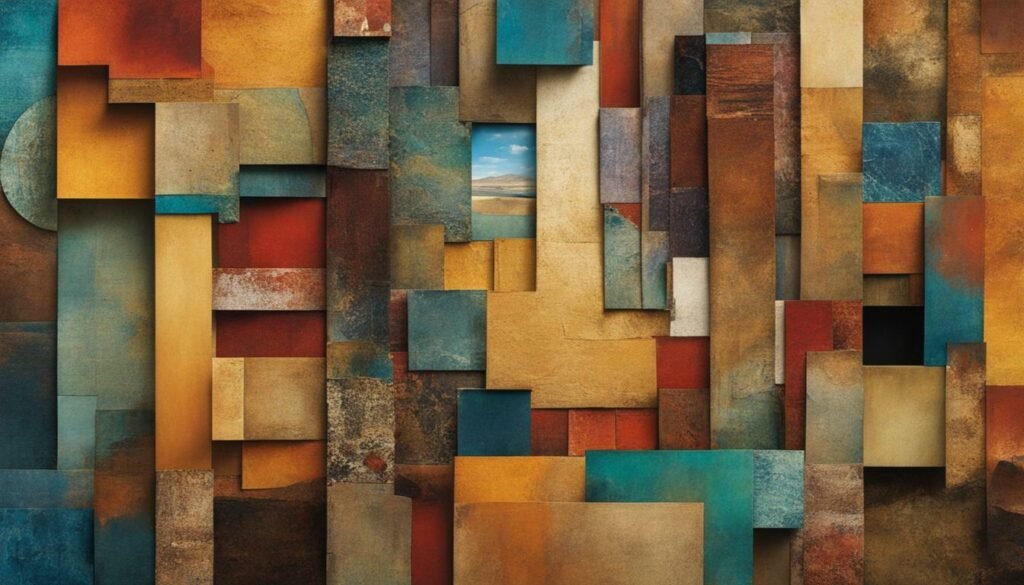
Styles of Collage Art
- Paper Collage: This is the most common type of collage, involving the use of different papers and textures.
- Found Object Art: This involves using everyday objects such as bottle caps, buttons, or even trash to create a new piece of art.
- Digital Collage: This is a newer form of collage that involves incorporating digital elements into a traditional collage.
Each style of collage art has its own unique techniques and approaches. But regardless of the style you choose, the fundamentals of collage art remain the same. So let’s dive deeper into the world of collage art and discover the techniques, materials, and concepts that will help you create enchanting works.
Mastering composition is one of the most vital collage techniques that you need to learn. Whether you’re using paper, fabric, found objects, or a mix of different materials, understanding how to arrange the elements of your collage is essential.
Here are some tips to help you achieve effective composition in your work:
- Use the rule of thirds to place your elements on your collage. Imagine your composition divided into thirds both horizontally and vertically, and place your focal points at the intersection of those lines.
- Consider the balance of color, shape, and texture in your collage. Create harmony by using similar shapes or colors throughout your composition, or add visual interest by using contrasting elements.
- Think about the hierarchy of elements in your composition. What elements do you want to stand out? Use visual weight to prioritize the most important elements in your collage.
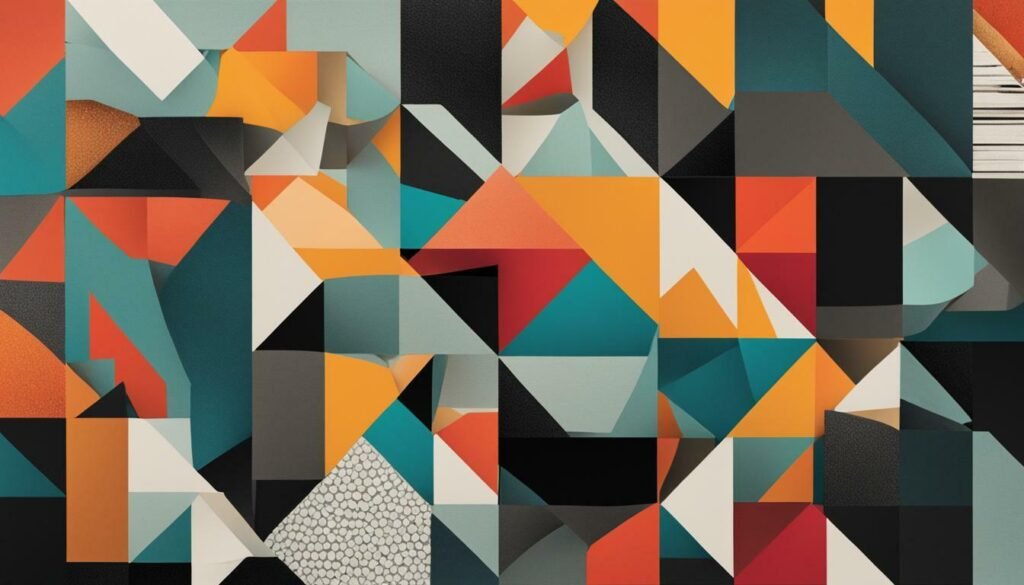
Using Texture in Collage
Texture adds depth and intrigue to your collage art. Incorporating different materials and methods can make your artwork truly stand out. Here are some collage techniques to add texture:
- Layering different papers with different textures, such as tissue paper, handmade paper, and patterned paper.
- Adding fabric or textured materials, such as lace, ribbon, and burlap, to your collage.
- Using various adhesives, such as gel medium, to create texture and dimension.
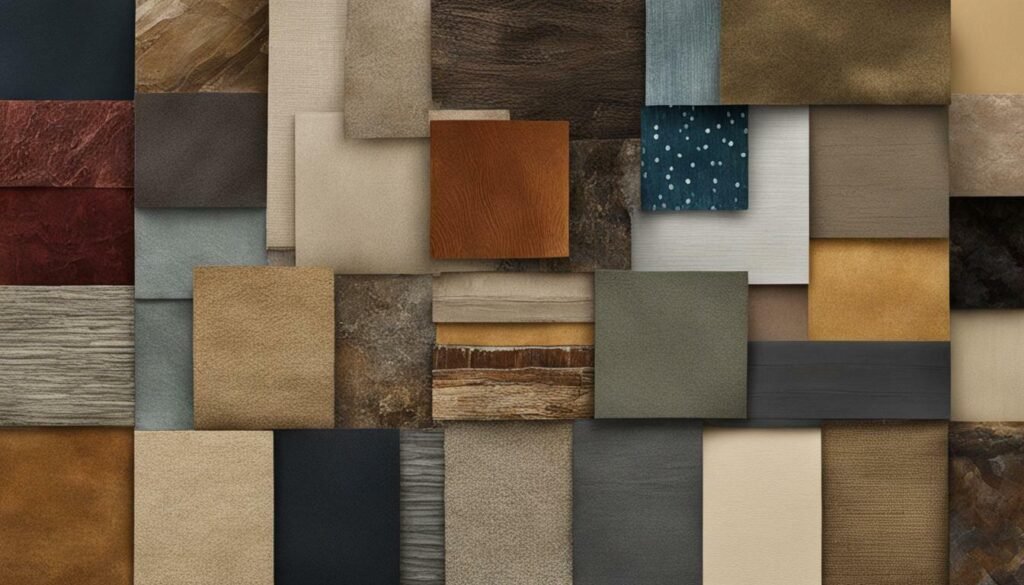
Color is an essential element in collage art, as it can evoke emotions, set the mood, and create stunning compositions. To create eye-catching and visually striking collages, you must understand how to use color harmonies, contrasts, and palettes effectively.
Here are some collage techniques to help you incorporate color into your artworks:
- Experiment with different color combinations, such as complementary, analogous, and monochromatic colors.
- Use color to create focal points, draw the viewer’s eye, and balance the composition.
- Layer papers with different colors to create depth or texture.
- Incorporate color into found objects to add interest and contrast.
- Consider the meanings and symbolism associated with different colors and use them to tell a story or convey a message.
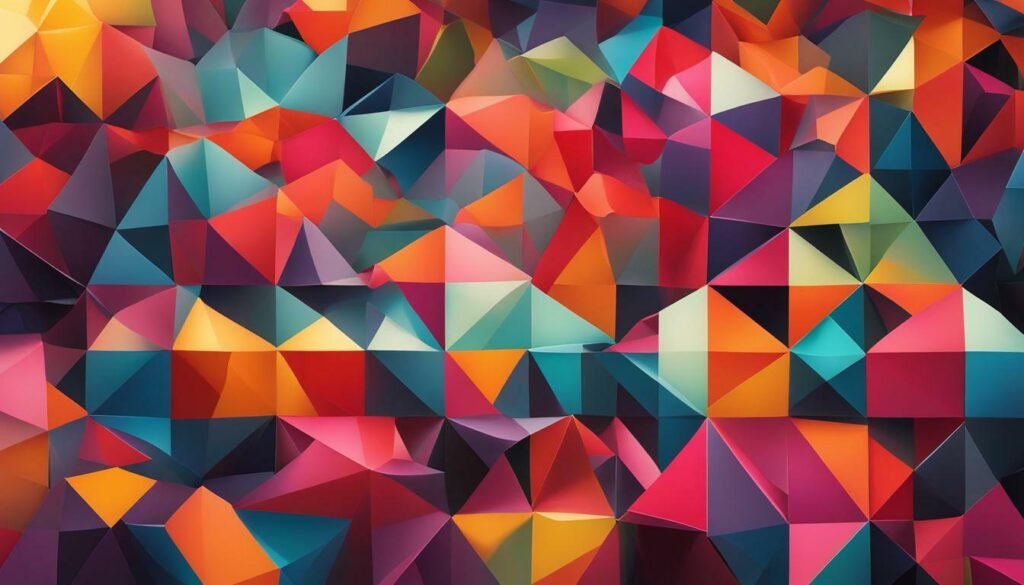
Layering Techniques in Collage
Layering is a fundamental technique in collage art that can create depth and interest in your pieces. By layering multiple elements, you can create visually captivating and complex compositions. Here are some layering techniques you can use:
- Tearing papers to create textured edges
- Using different weights and textures of paper
- Overlapping papers to create depth
- Adding fabric or textured materials
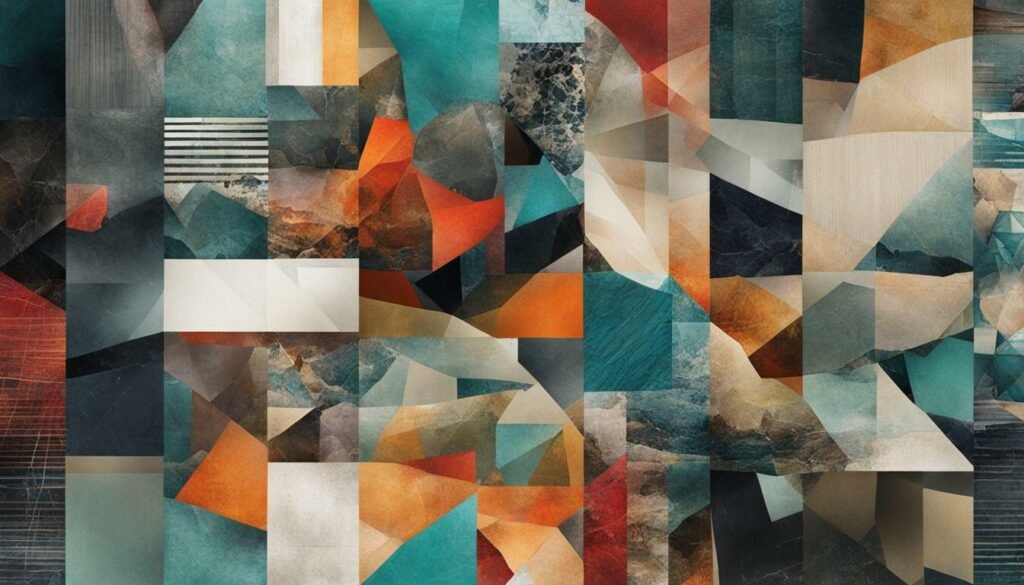
Exploring Contemporary Collage Art
Contemporary collage art is a vibrant and dynamic field that draws from a wide range of materials and techniques.
It is characterized by its innovative approaches to storytelling, use of digital media, and incorporation of found objects.
- Contemporary collage artists push the boundaries of traditional techniques, experimenting with new materials and processes to create works that are both visually stunning and conceptually thought-provoking.
- Many contemporary collage artists draw inspiration from popular culture, politics, and social issues, creating works that are both timely and timeless.
- Others explore the intersection of digital and analog media, incorporating elements of both traditional collage and digital manipulation to create hybrid works that blur the boundary between the real and the virtual.
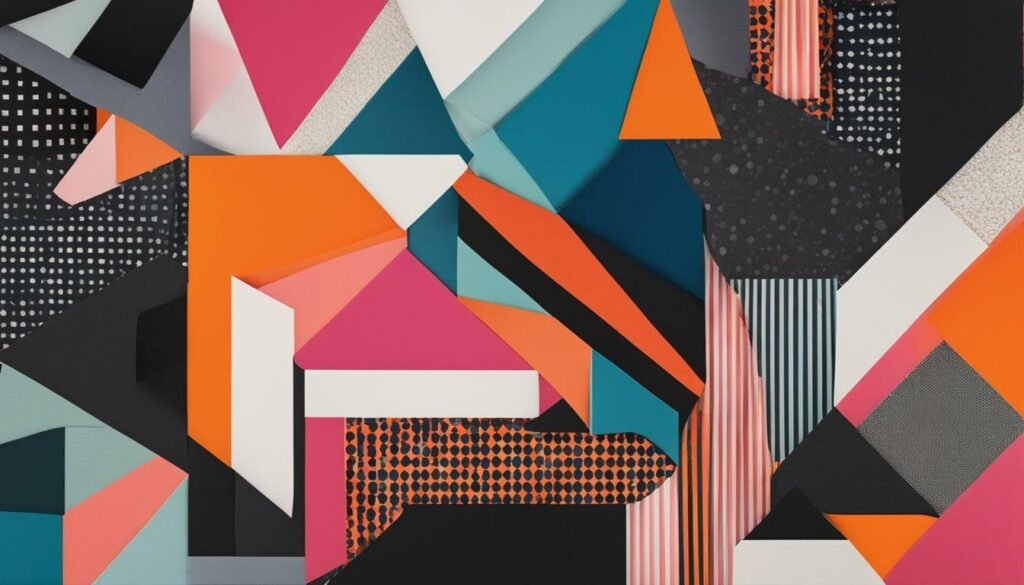
Step-by-Step Collage Tutorials
If you’re a beginner or looking to improve your collage art skills, step-by-step tutorials can guide you through the process and help you create stunning artworks. Here are some collage techniques to explore:
- Layering: Experiment with different layering techniques, such as tearing, cutting, or overlapping papers, to add depth and dimension to your collage.
- Texture: Incorporate texture into your collage by layering papers, adding fabric or textured materials, or using various adhesive methods.
- Color: Use color to evoke emotions and set the mood in your collage. Explore color harmonies, contrasts, and palettes to enhance your artworks.
- Composition: Mastering composition is key to creating visually pleasing collages. Learn the principles of composition and how to effectively arrange elements in your artwork.
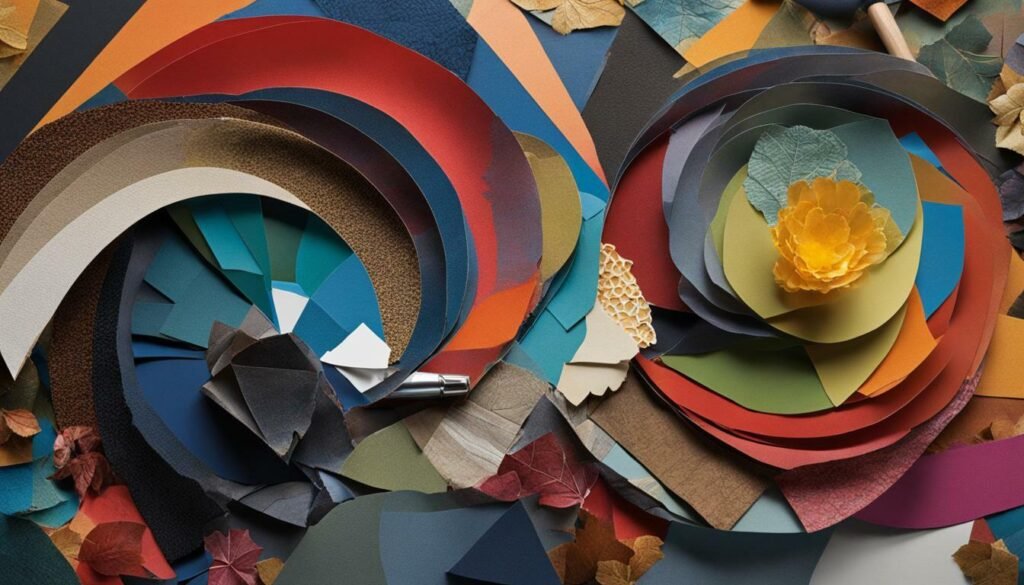
Expand your collage art practice by incorporating different materials and techniques. Mixed media collage allows you to combine various mediums, such as painting, drawing, printmaking, and found objects, into your collage works.
Here are some ideas to get you started:
- Layer magazine clippings over a painted background to add depth and interest to your collage.
- Use fabric scraps or threads to add texture and tactile elements to your artwork.
- Paint or draw directly onto your collage to add details or create a cohesive composition.
- Experiment with different types of adhesives, such as gel mediums or spray mount, to adhere materials onto your collage.
- Combine found objects, such as buttons, trinkets, and natural elements like leaves or flowers, with paper elements to create a unique narrative in your artwork.

Collage art is all about creativity and inspiration. Here are some tips to help you find inspiration for your next collage masterpiece:
- Take a nature walk and gather interesting leaves, flowers, and other natural objects that catch your eye
- Visit an art museum or gallery to see how other artists use collage techniques to create beautiful works
- Flip through magazines and cut out images and words that speak to you
- Experiment with different color palettes and textures to create unique combinations
- Keep a collage art journal to collect and curate visual references that inspire you
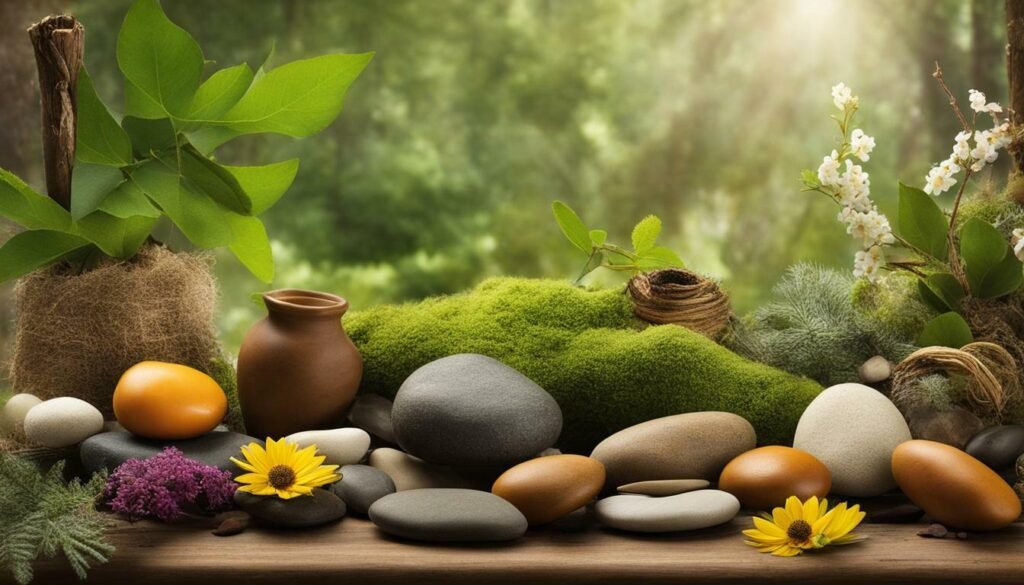
Collage art comes in many styles, each with its own unique techniques and concepts. Whether you prefer abstract, figurative, or surreal, there is a style of collage art that fits your artistic vision. Here are some styles to explore:
- Abstract: This style of collage art focuses on color, shape, and texture, rather than representing real-life objects or scenes. Abstract collages often use bold shapes and contrasting colors to create dynamic compositions.
- Figurative: Figurative collage art features recognizable objects, people, or landscapes. This style often involves cutting and pasting images from magazines or newspapers to create a cohesive scene.
- Realistic: With a focus on creating lifelike representations of objects or scenes, realistic collage art requires precision cutting and layering. This style often involves using a variety of papers and textures to create a sense of depth and dimension.
- Surreal: Surrealist collages play with the juxtaposition of unexpected images to create dreamlike compositions. This style often involves deconstructing and reassembling images to create new meanings and associations.
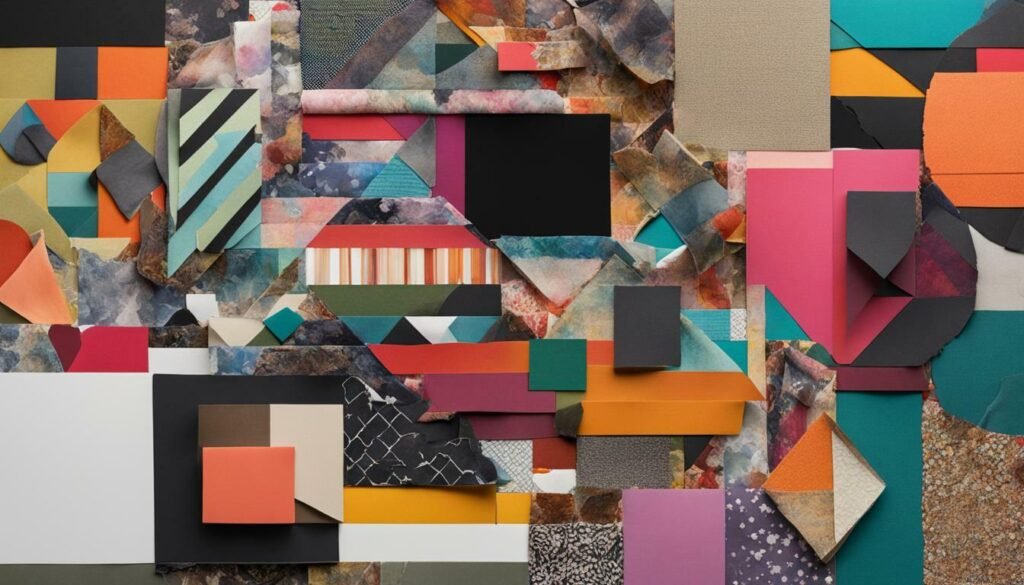
Found objects can add a unique touch to your collage art. These objects could be anything from a leaf or a feather to a ticket stub or a torn piece of fabric.
Incorporating found objects into your collages can add texture, dimension, and character to your artworks, and can even tell a story.
Here are some tips for using found objects in your collage art:
- Collect a variety of objects that catch your eye, and keep them organized in a container or a drawer.
- Think about the story or emotion that you want to convey in your artwork, and choose objects that contribute to that narrative.
- Experiment with different adhesives and techniques for attaching your found objects, such as sewing, stapling, or wire wrapping.
- Consider the aesthetic of your found objects, and how they fit in with your overall composition in terms of color, texture, and shape.
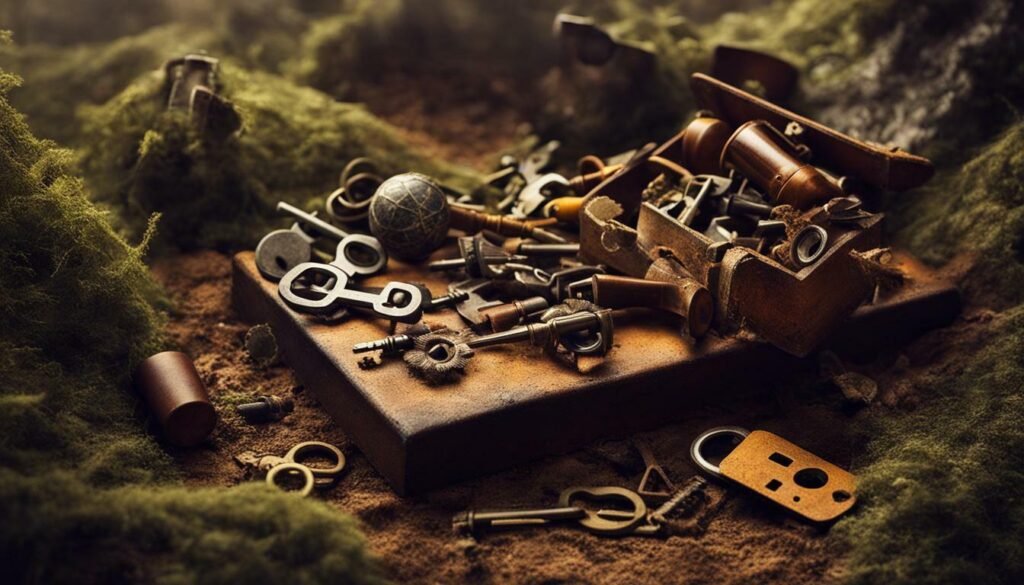
Exploring Digital Collage
Collage art doesn’t have to be limited to traditional materials. With the use of digital tools, you can create stunning and unique collages. Here are some techniques to consider:
- Use photo editing software such as Photoshop or GIMP to cut and paste digital images to create collages.
- Experiment with layering and blending modes to create interesting effects.
- Incorporate scanned images of physical elements, like papers or textures, into your digital collage.
- Explore the use of digital brushes to add texture and detail to your artwork.
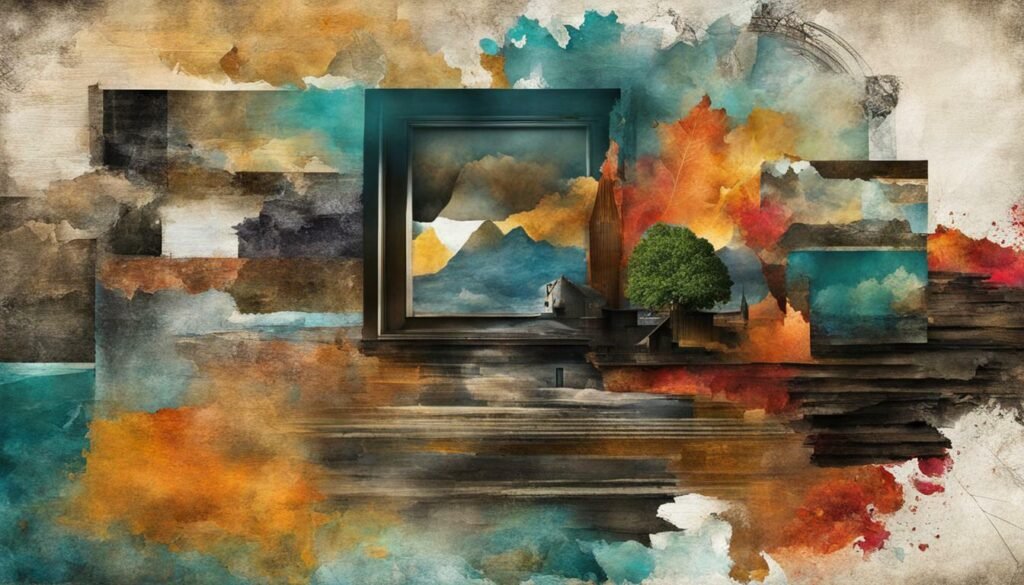
Sharing your collage art is an exciting step in your artistic journey. Here are some tips to help you showcase your work:
- Create a portfolio website to showcase your collages and your artistic background.
- Share your work on social media platforms to reach a wider audience. Use relevant hashtags and engage with other artists to grow your following.
- Enter your work into local art competitions or exhibitions to gain exposure and recognition.
- Consider selling your artwork on online marketplaces or during local art fairs and festivals.
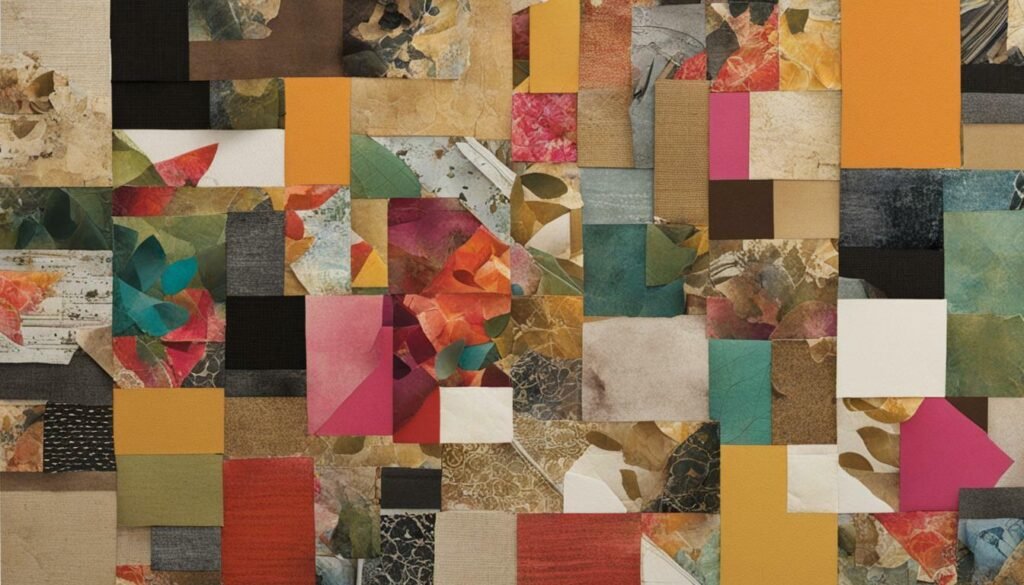
You have now delved into the fundamentals of collage art and explored techniques, concepts, and materials to enhance your artistic flair. Remember to:
- Understand the history and evolution of collage art
- Master composition and color to create harmonious and impactful collages
- Experiment with texture and layering techniques to add depth and interest
- Find inspiration everywhere and explore different styles of collage art
- Embrace digital tools to expand your artistic practice
- Share your collages with the world and celebrate your unique voice and style
FAQ
What is collage art?
Collage art is a form of mixed media art that involves arranging and combining various materials, such as paper, fabric, photographs, and found objects, to create a visual composition.
What are the fundamentals of collage art?
The fundamentals of collage art include understanding composition, utilizing texture, exploring color, and mastering layering techniques.
How do I incorporate texture into my collage artworks?
You can incorporate texture into your collage artworks by layering papers, adding fabric or textured materials, and using various adhesive methods. Experiment with different techniques to create tactile and visually engaging pieces.
What role does color play in collage art?
Color plays a vital role in evoking emotions and setting the mood in collage art. By understanding color harmonies, contrasts, and palettes, you can enhance your collages and create eye-catching compositions.
How can I get inspiration for my collage art?
Inspiration for collage art can be found everywhere. Take nature walks, visit art museums, and collect visual references that ignite your creativity and guide your artistic journey.
Is it possible to combine collage with other art mediums?
Yes, collage can be combined with other art mediums such as painting, drawing, and printmaking. This creates mixed media collage artworks, offering dynamic possibilities for artistic expression.
How can I exhibit and share my collage art?
There are various ways to showcase and share your collage art. Consider using online platforms, local galleries, or creating your own exhibitions. Document and photograph your artworks effectively to capture their essence and share them with the world.
